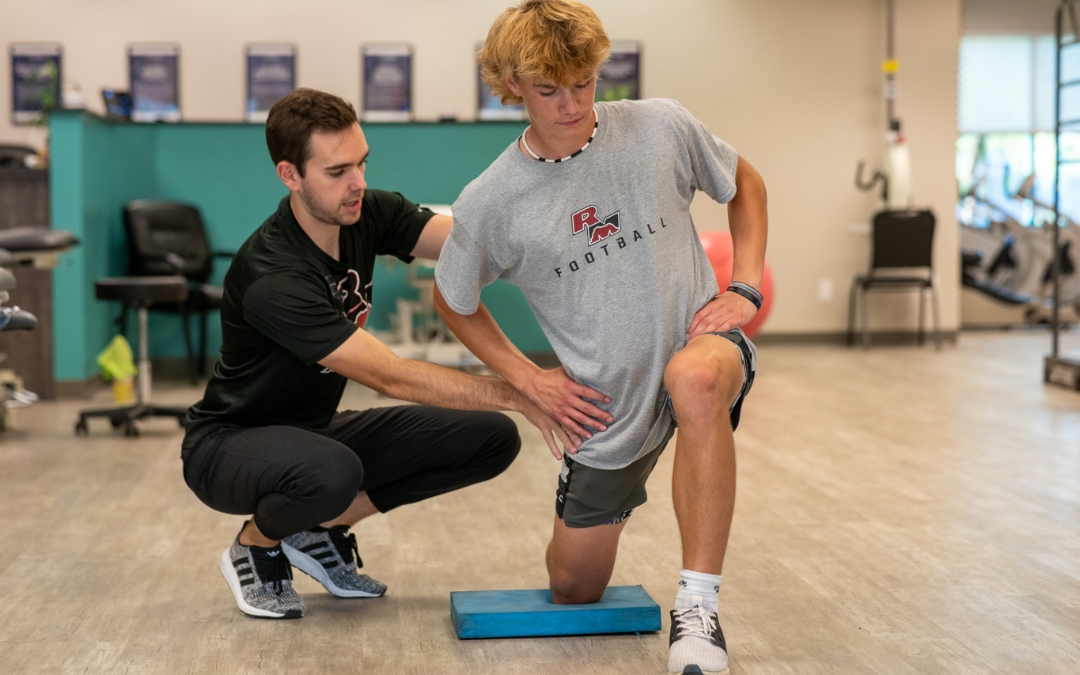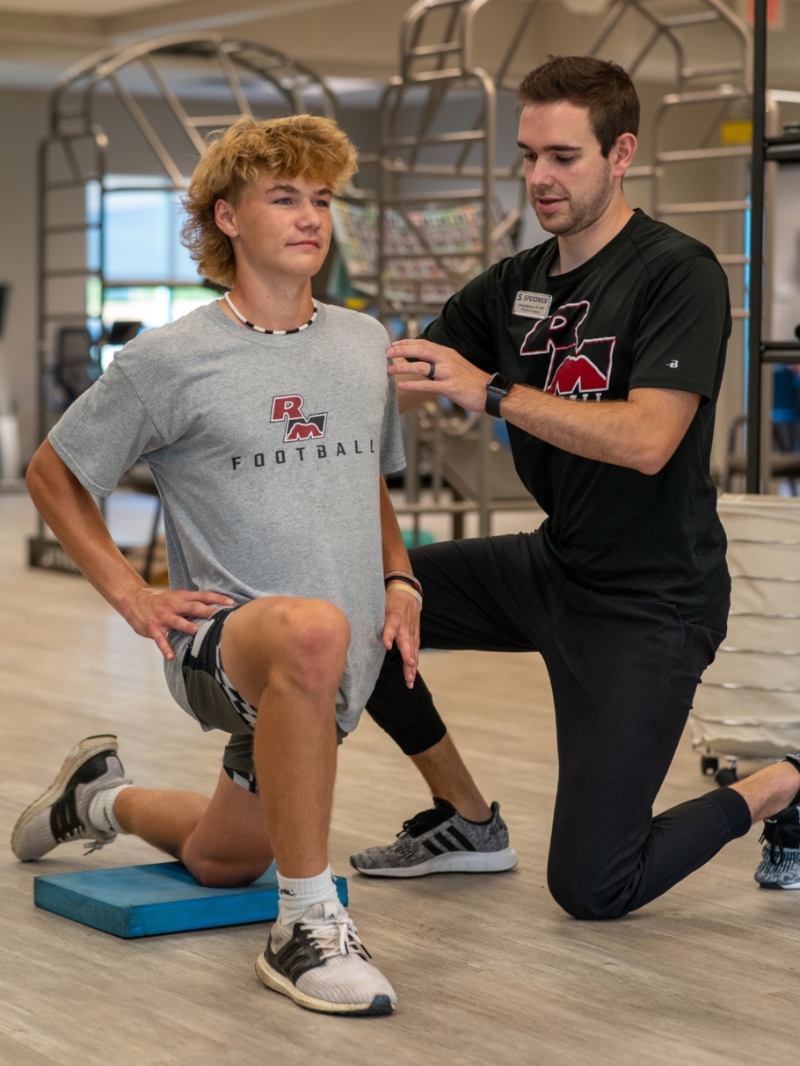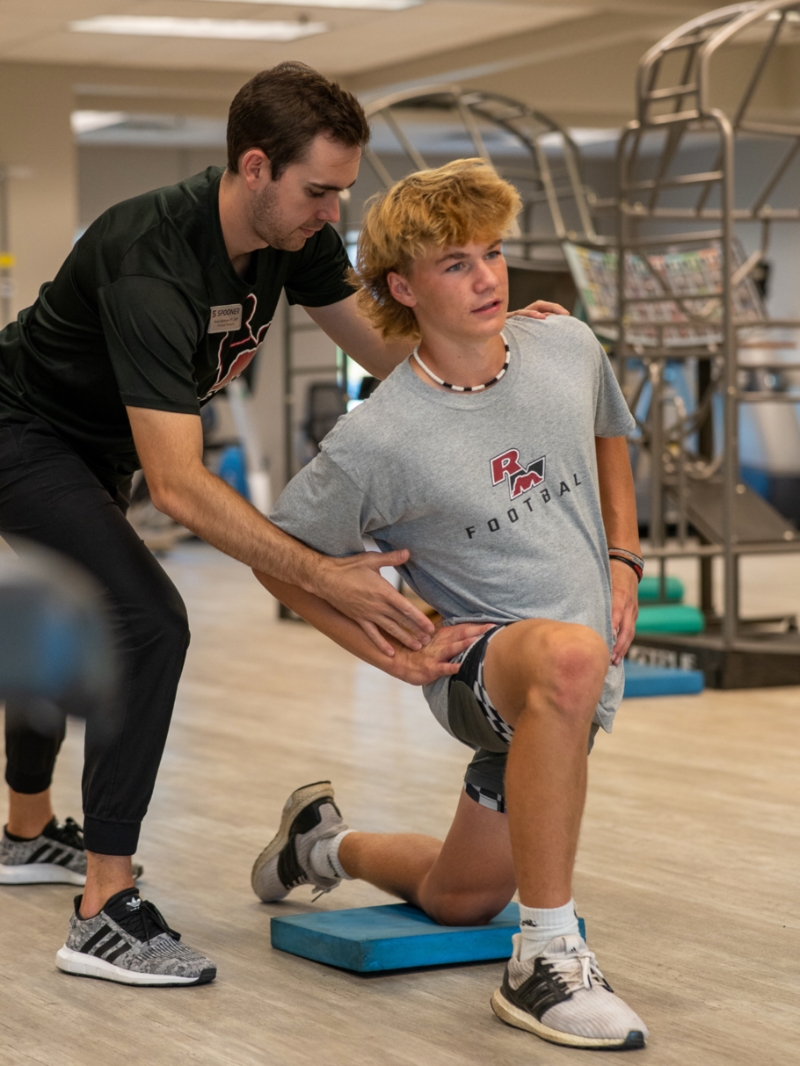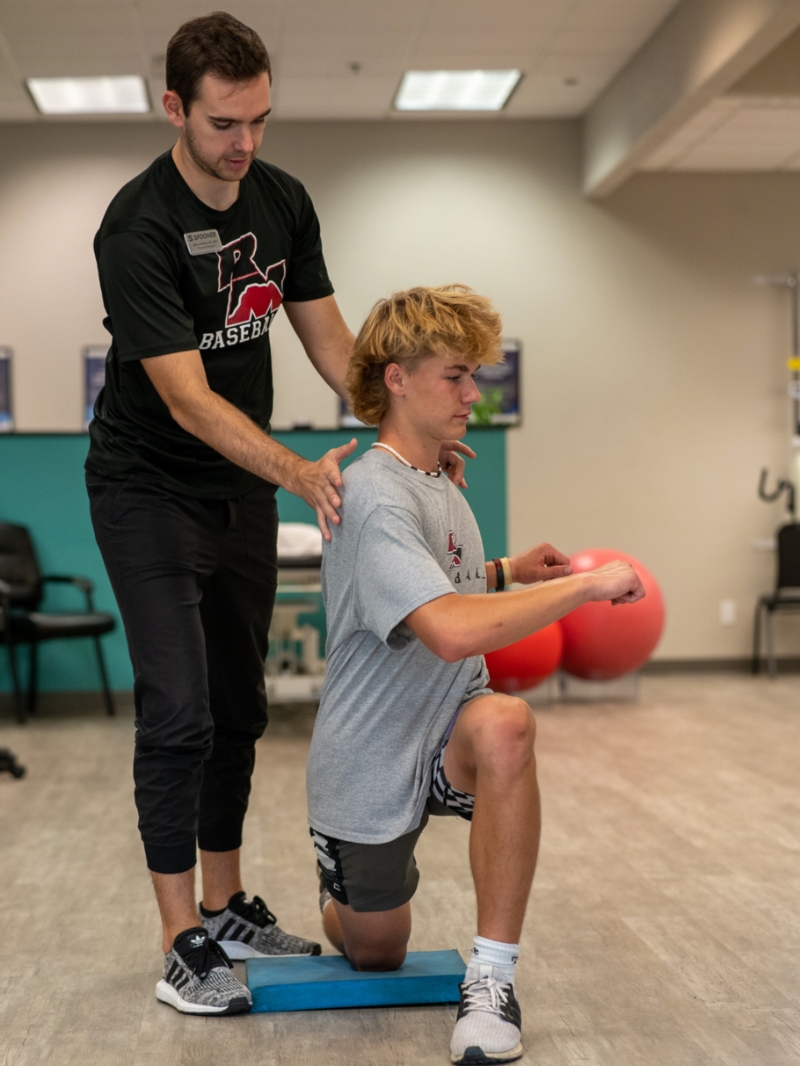Youth athletes are getting stronger every year. However, while they are growing, they are still at risk of injury. So, what can be done to help them stay on the field?
On the Sports Medicine Team at Red Mountain High School, Spooner therapist Brian Bettner, PT, DPT, saw a consistent lineup of young athletes with similar knee complaints. He programmed a sport specific plan to help Red Mountain High School athletes perform their best.
I work with Red Mountain High School alongside their athletic trainer, Shelli Herseth, MA, ATC, as a part of her Sports Medicine Team. Throughout the 2021-2022 school year, we were able to perform athlete screens, give assistance on the field, and treat athletes in a multitude of sports.
Shelli and I were reflecting over the 21-22 season, discussing successes, failures, and trends we both saw. In our conversations, we noticed that there was an unusually high volume of knee injuries. When you hear knee injuries, you may think of the common suspects – ACL, meniscus, and even MCL – but this wasn’t the case. All of the knee pain cases that came up were patellar tendon pain. Even more so, it was all seen in our younger athletes: freshman and sophomores, and maybe a handful of juniors.
After doing some research and digging in, we realized that over the course of the year, I saw 35 athletes total from RMHS. Of those athletes, 12 came in with primary complaints of patellar tendon pain. This common theme in clinic was echoed further by Shelli. She had an even higher number of acute patellar tendon pain athletes that were only treated by her and did not make it to the team physician or PT. What could be the possible causes of these issues?
Growth Plates
There is a growth plate just below the knee where the patellar tendon attaches. A growth plate is a soft portion of the bone, usually located at either end of the bone, and it helps bones form and grow. Tissues and tendons are attached to the softer parts of the bone and are at risk of injury if loaded too heavily. If the growth plate is injured while it is open, it can lead to further injuries down the road.
Research has shown that patellar tendon pain affects people who perform high impact activities – like running and jumping – as well as people who are growing. The RMHS Team physician, Dr. Alex Onofrei, used diagnostic ultrasound to identify signs of patellar tendinitis and had also seen this in several athletes throughout the year with current openings in their growth plates. As Dr. Onofrei reviewed cases from 21-22 school year, 12 of 35 athlete cases were referred for patellar tendon pain and 6 of those 12 showed active growth with open growth plates through the tibial plateau.
Strain on the Athlete
On top of these athletes growing, their tendons and tissues are put under massive strain in a few different ways on and off the field.
The young athlete population is in the weight room a lot more. This is a good thing! But, just like anything else, while athletes are growing, they may require different programs to be put in place to help protect them. Kids are getting into pre-lifting programs in middle school and into their early high school years. In regards to strain, the athletes with patellar tendon issues may be building up a lot of quad strength, and their bones are trying to catch up with their muscle growth. It’s all pulling on that patellar tendon, which can cause pain.
After speaking with athletic trainers and coaches, another possible strain on the patellar tendon can be due to the switch to artificial turf in high schools across the valley. With district-wide artificial turf upgrades, it is important to consider the different ground reaction forces that occur with high impact sports and how we can best prepare our athletes for this change.
Finally, and most importantly, I noticed that, of the 12 athletes with patellar pain, all were single sports athletes. These highly specialized athletes were doing the same repetitive motions, and they are trying to perfect one specific thing. All of the athletes were participating in high running and jumping sports, like track, soccer, and football. Without diversifying their sport and their athletic movements, they are just repetitively straining their body in the same way over and over again.
To learn more about youth sports specialization, read The Need for an Off-Season here.
5 Ways to Prepare Youth Athletes
On the sports medicine side, we cannot change an athlete’s growth rate, the sport they play, the surface on which they run, and we certainly don’t want to take them out of the weight room. So, what can physical therapists, athletic trainers, and strength coaches do to prepare their athletes and prevent further ailments– especially through the patellar tendon?
- 1) Work Together as a Sports Medicine Team.
- As I mentioned, Red Mountain’s athletic trainer, Shelli, and myself have collaborated on the athletes’ care. We have also been lucky enough to have a strength coach to work with as well. This has allowed all of us to bring our expertise to the table and once we have identified an issue work together on a solution that may help reduce the chance of these injuries in the future. Having the whole Sports Medicine Team, including the team physician, collaborate on care is ultimately the best way to set our athletes up for success.
- 2) Screen our athletes prior to heavy field time.
- The Spooner Sports Medicine Team uses a comprehensive sports medicine screen to look head to toe at mobility and strength limitations that could identify possible injuries or changes in performance. For example: identifying hip tightness or immobility through ankles can allow us to create plans that prepare the knee for movement prior to improper forces being placed through patellar tendon.
- 3) Load our athletes in all three planes of motion.
- All sports and positions have forces acting on them in sagittal, frontal, and transverse plane. The growing athlete’s body needs to be ready for it. Identifying movement patterns early and training our athletes into movements that their body may be more challenged in will help them develop into a well-rounded athlete. An example I use with all my athletes dealing with patellar pain is ½ kneeling hip flexor stretching with added pelvic drivers in all three planes. This isolates hip flexors and quads with added stress placed through the muscle in 3 different planes without placing stress on patellar tendon.
- 4) Strengthen muscle attachments to patellar tendon with eccentric loading.
- Eccentric loading is performing active muscle contractions while the muscle is lengthened rather than shortened. Eccentric loading will place the highest amount of tolerable load in a safe manor through the patellar tendon and can build strength to decrease pain and improve performance. Anterior step downs are a great place to start and can easily be progressed to full step downs with top-down drivers that allow you to mimic sport demands for each and every athlete.
Learn more about eccentric loading in How to Build Tendon Strength: Eccentric, Isometric, and Plyometric Training on the Spooner blog.
- 5) Provide manual treatment when pain is present.
- Dry needling through quadriceps and patellar tendon, IASTM, and cupping through quadriceps muscle are all great options for manual therapy when the growing athlete is experiencing pain. Manually resisted eccentrics and dynamic reversals through knee flexion and extension will teach the athlete to load and control forces placed through the knee while also increasing strength.
As we progress into the 2022-2023 school year, these actionable steps from the Sports Medicine Team will help prepare the athletes for the season and prevent this trend of patellar tendon pain from occurring.
If you are an athlete and are struggling with any pain or an injury, schedule an appointment with a Spooner therapist today!




